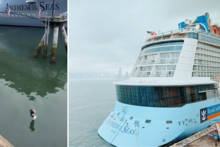Can a floating city of 6,000 passengers per week touring holiday and not leave behind a sea of waste? Cruise companies fight tooth and nail that they follow environmental policies, and ensure that they meet international standards even with the challenge of being sustainable and non-polluting by the account that brings. Only in Spain, in the first half of the year there have been 3.2 million cruise passengers, 17.7% more than the same period of 2010, a total of 1,632 large ships. And the craze for this type of trip, relatively new in Europe, has for decades sweeping the United States.
 Each cruise company usually develops its own sustainability plans. One of the largest in the world, Royal Caribbean, said that for 40 years have implemented various measures "to protect the environment," but it was in 1992 when they launched the Save the Waves program, focusing on the "reduce, reuse and recycling waste" in all vessels in its fleet.Royal Caribbean monitors their ships pollution (managing the tons of garbage produced daily) and strictly prohibiting passengers to throw any litter overboard. In fact there are cameras that could determine from which little cabin is thrown into the sea.
Each cruise company usually develops its own sustainability plans. One of the largest in the world, Royal Caribbean, said that for 40 years have implemented various measures "to protect the environment," but it was in 1992 when they launched the Save the Waves program, focusing on the "reduce, reuse and recycling waste" in all vessels in its fleet.Royal Caribbean monitors their ships pollution (managing the tons of garbage produced daily) and strictly prohibiting passengers to throw any litter overboard. In fact there are cameras that could determine from which little cabin is thrown into the sea.
Royal Caribbean places posters in the restrooms asking not to throw the towels on the floor unless changes are required to avoid unnecessary washing and reduce pollution.
Royal Caribbean has on its ships an environmental program officer, whose duty it is to instruct the crew about managing waste. Royal Caribbean's procedures were the first certified ISO 14001 in the sector.






